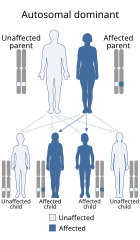| Shprintzen–Goldberg syndrome | |
|---|---|
| Other names | Marfanoid craniosynostosis syndrome[1] |
 | |
| Shprintzen–Goldberg syndrome is inherited in an autosomal dominant manner | |
Shprintzen–Goldberg syndrome is a congenital multiple-anomaly syndrome that has craniosynostosis, multiple abdominal hernias, cognitive impairment, and other skeletal malformations as key features. Several reports have linked the syndrome to a mutation in the FBN1 gene, but these cases do not resemble those initially described in the medical literature in 1982 by Shprintzen and Goldberg,[2] and Greally et al. in 1998 failed to find a causal link to FBN1.[3] At this time, the cause of Shprintzen–Goldberg syndrome has been identified as a mutation in the gene SKI located on chromosome 1 at the p36 locus. The syndrome is rare with fewer than 50 cases described in the medical literature to date.[citation needed]
Signs and Symptoms[edit]
People with Shprintzen-Goldberg syndrome can experience a range of symptoms that vary in severity. Due to craniosynostosis, people with SGS may have a long and narrow head, wide spaced protruding eyes that may slant downwards, a high and narrow palate, a high and prominent forehead, a small lower jaw, and low-set posteriorly-rotated ears. Some other skeletal abnormalities people with SGS may experience include joint hypermobility, clubfoot, scoliosis, camptodactyly, arachnodactyly, long limbs, and a chest which appears to sink in or stick out. Other symptoms that may be experienced include brain abnormalities (i.e. hydrocephalus), developmental delays, intellectual disability, gastrointestinal problems (i.e. constipation, gastroparesis), abdominal or umbilical hernias, easily bruised skin, trouble breathing, and hypotonia. Some cardiac issues which are occasionally seen in people with SGS include aortic aneurysm, aortic regurgitation, aortic root dilation, mitral valve regurgitation, and mitral valve prolapse.[4]
See also[edit]
References[edit]
- ^ RESERVED, INSERM US14-- ALL RIGHTS. "Orphanet: Shprintzen Goldberg syndrome". www.orpha.net. Retrieved 22 October 2019.
{{cite web}}: CS1 maint: numeric names: authors list (link) - ^ Shprintzen, RJ; Goldberg, R (1982). "A recurrent pattern syndrome of craniosynostosis associated with arachnodactyly and abdominal hernias". Journal of Craniofacial Genetics and Developmental Biology. 2 (1): 65–74. PMID 6182156.
- ^ Greally MT, Carey JC, Milewicz DM, Hudgins L, Goldberg RB, Shprintzen RJ, Cousineau AJ, Smith WL Jr, Judisch, GF, Hanson JW (1998). "Shprintzen-Goldberg syndrome: a clinical analysis". American Journal of Medical Genetics. 76 (3): 202–212. doi:10.1002/(SICI)1096-8628(19980319)76:3<202::AID-AJMG2>3.0.CO;2-S. PMID 9508238.
- ^ "Shprintzen-Goldberg Syndrome". Cleveland Clinic. Retrieved 25 February 2023.